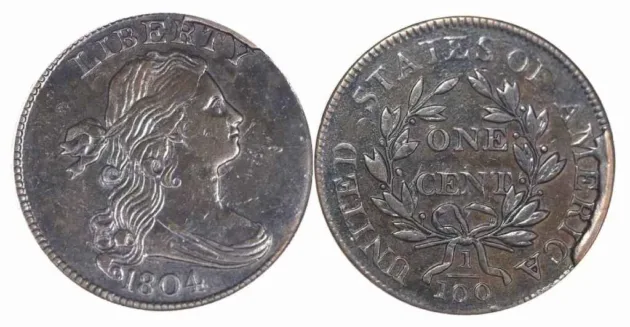Many collectors want to know what their Draped Bust large cents are worth.

But there are many variables when it comes to Draped Bust penny values.
In this article, we are going to delve into the history of these coins and reveal how much Draped Bust large cents are worth today.
The History Of Draped Bust Large Cents
The Draped Bust large cents were first released in 1796, following the issuance of the Flowing Hair and Liberty Cap large cents that were produced from 1793 through 1796.
The Draped Bust design came in at a time when several denominations of United States coins were undergoing redesigns with similar side-profile portraits of Miss Liberty. In fact, variations of the Draped Bust design have played out on virtually every denomination of U.S. coin — from the half cent through the gold eagle coin denominated to $10.
While the Draped Bust motif anchored the large cent on the obverse (“heads side”) of the penny through 1807, there were a few minor modifications to the design during that time. There were also several changes to the reverse (or “tails side”) during the period.
These changes are very important to series enthusiasts, or those who try collecting all iterations of the Draped Bust large cent.
Collecting Draped Bust Large Cents
A good deal of people who buy a Draped Bust large cent may be doing so to buy just one to include in a larger type set of United States coinage.
But there are also collectors who will spend many years — decades, even — pursuing every possible different type of large cent they can find. In fact, there are hundreds of distinct varieties among the large cents made from 1793 through 1814.
With the Draped Bust large cents there are many dozens of varieties, though some are much rarer than others. This is partly the result of there being very few people who collected these coins at the time — with most of the coins being spent as money and worn or damaged beyond collectability.
Thankfully, many of these coins were saved in one form or fashion, and small numbers still exist for collectors today.
However, uncirculated examples are rare, as are some dates even in well-worn condition.
All Draped Bust large cents are worth good money above face value!
Draped Bust Large Cent Value
Many Draped Bust large cents are quite valuable today.
Why is this? Because despite many of these coins having mintages in the tens of thousands and even hundreds of thousands, there are relatively few left… Even the most “common” dates may offer only a few thousand specimens these days.
In the cases of the varieties, it’s often the case that just a few dozen to maybe a few hundred apiece exist — which is quite rare in the world of coin collecting. Many varieties are elusive, with years and years sometimes elapsing between auction appearances of certain varieties.
Between the relatively low populations of Draped Bust large cents and the high number of people who want to collect them, values for these old pennies are unsurprisingly quite high across the board:
- 1796 Reverse of 1794 — $450+
- 1796 Reverse of 1795 — $550+
- 1796 Reverse of 1797 — $500+
- 1796 LIHERTY — $1,250+
- 1797 Rev of 1795, Plain Edge — $375+
- 1797 Gripped Edge — $450+
- 1797 Reverse of 1797, Stems — $250+
- 1797 Reverse of 1797, No Stems — $300+
- 1798/7 — $325+
- 1798 Reverse of 1795 — $400
- 1798 1st Hair Style — $150+
- 1798 2nd Hair Style — $225+
- 1799 — $7,000+
- 1799/8 — $9,000+
- 1800 — $150+
- 1800/1798 — $175+
- 1800/79 — $150+
- 1801 — $125+
- 1801 3 Errors — $300+
- 1801 1/000 — $200+
- 1801 100/000 — $350+
- 1802 — $125+
- 1802 1/000 — $275+
- 1802 No Stems — $125+
- 1803 Small Date, Small Fraction — $120+
- 1803 Small Date, Large Fraction — $125+
- 1803 Large Date, Small Fraction — $9,000+
- 1803 Large Date, Large Fraction — $250+
- 1803 100/000 — $175+
- 1803 No Stems — $150+
- 1804 — $2,250+
- 1805 — $125+
- 1806 — $110+
- 1807/6 Small 7 — $4,250+
- 1807/6 Large 7 — $150+
- 1807 Small Fraction — $120+
- 1807 Large Fraction — $100+
- 1807 Comet — $150+
- 1804 Private Restrike — $300+
*Values above are for coins that have not been cleaned and contain no holes, major scratches, or other kinds of damage. These prices correspond to coins that grade Good-4, and the plus (+) sign indicates that values for each given Draped Bust large cent go higher from there, usually in correlation to examples in higher grades.
What Is The Most Valuable Draped Bust Large Cent?
As you peruse the list of Draped Bust penny values above, you’ll see some dates stand out as very valuable — with the 1799 and 1804 among these.
You’d be correct in guessing that those two dates are very rare, with perhaps 700 examples of the 1799 Draped Bust large cent in existence and maybe 1,000 of the 1804 Draped Bust large cent.
The 1799 Draped Bust large cent became one of the most important rarities of American coin collecting during the mid-19th century, when the hobby really began taking off in the United States. While several hundred specimens turned up over the years in circulated grades, an uncirculated example wouldn’t turn up in the United States until the 1920s. That example was eventually graded Mint State-61 Brown by Professional Coin Grading Service and sold for $977,500 in 2009.
The 1804 Draped Bust large cent is another great rarity from a special year for the series, with only small numbers known today for this key-date coin. In 2009, an example graded Mint State-63 Brown by Professional Coin Grading Service hammered for $661,250.




